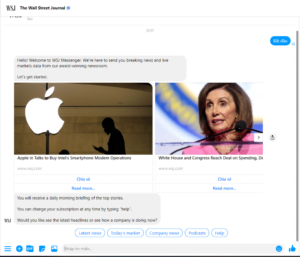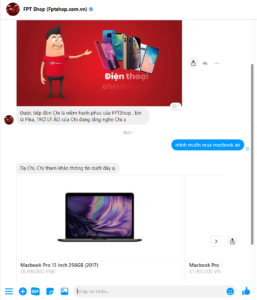The chatbot’s personality is expressed throughout the conversation, from greetings, explanations, information about services, to asking questions and answering user inquiries. A chatbot that earns the goodwill of users not only meets customer needs but also makes them feel interested.
Several factors affect the communication style of the chatbot. One of them is how the conversation begins; instead of trying to hide it, you can let customers know they are communicating with a bot rather than a real person. Transparency from the outset will help users be more open and enthusiastic about chatting with the bot. Let the chatbot send customers a clear welcome message along with a brief introduction about itself.
To have natural and seamless conversations, this article introduces a few helpful tips to win the hearts of customers:
1. Chatbot Reflects Your Users’ Personality
A chatbot can mimic customers’ personalities by writing in their style. For instance, if most of your customers are women aged 35-50, avoid building the bot’s personality as that of a female student.
Instead, familiarize yourself with your users’ personalities, understand their life experiences, interests, culture, and daily language habits. Your chatbot will not annoy customers if its personality harmonizes with that of the users.
Knowing your users helps you determine the level of friendliness, humor, and information you should provide from the start.
For example, The Wall Street Journal’s chatbot has built its chatbot aimed at its users. The average reader of the journal is 49 years old and earns close to $200,000 per year. Their readers consist of 45% women and 55% men. For this user group, The Wall Street Journal’s chatbot greets users with the word “Hello,” which is both polite and friendly, and then quickly transitions to information options and articles. This is one of the subtle points of The Wall Street Journal, as their readers are all experts and businesspeople. They are extremely busy and want to quickly find what is useful and necessary for them.

However, you can create a more humorous and playful chatbot like Domino’s Pizza has done. DOM The Pizza Bot greets customers with a witty “I’m just a dough ball, which pizza flavor would you like?” Then, it offers two buttons: PIZZA/HELP for customers to choose pizza types in the PIZZA menu or other requests in the HELP section. Domino’s chatbot is simple, straightforward, yet charming.

Understanding the buyer’s personality and reflecting it through the chatbot provides experiences that make users feel most comfortable.
2. Defining Your Chatbot’s Personality Traits
Apart from offering an honest, useful conversation that suits the buyer’s personality, you can also add a touch of playfulness or friendliness to the conversation.
Have you chosen a suitable name for your bot? Are you approaching customers in a professional, polite, or fun, humorous, youthful manner? Is the chatbot male, female, or gender-neutral? What age group does the bot belong to?
The bot’s personality will encompass which traits? You can shape the bot’s style based on the brand’s or company’s personality. However, you can also amplify the bot’s style slightly to make it more exciting.
For example, Pika, the virtual assistant from FPT Shop, is a product of the FPT.AI platform, integrated with artificial intelligence, to help FPT Shop provide daily customer care. Pika is male, with neatly styled hair, polite attire featuring the FPT Shop logo, creating trust for users.

Some personality traits to consider include whether the bot is introverted or extroverted, humorous or serious, gentle or lively. A simple, useful, and courteous chatbot is an optimal choice for many brands.
A simple chatbot with the ability to advise and close orders could be a choice for many businesses, suitable for regular customer groups. However, if your customers seek interesting product or service experiences, you should consider adding playfulness or humor to your chatbot.
3. Preparing for Unexpected Questions
Sometimes, your chatbot will need to answer questions not related to the information you intended to provide. How will you handle these situations? Respond dryly or humorously?
For instance, Apple’s virtual assistant Siri is a chatbot programmed to work in sync with human thinking. One of the reasons Siri is beloved is because of her witty responses to random questions. When users receive a clever answer to silly questions, they are impressed by Siri’s response abilities.

Building a personality for the bot to answer off-topic questions is one of the ways to make the chatbot more approachable to users. The surprises and delights the chatbot brings to customers go beyond a simple conversation; they create a human connection.
Understanding users and developing a chatbot personality that aligns with users’ personas are essential elements for the success of the conversation. When users feel heard, understood, and receive thoughtful answers to their queries, they will trust in the product or service and value your brand highly.








